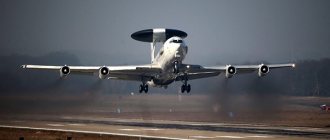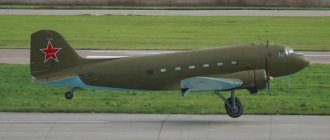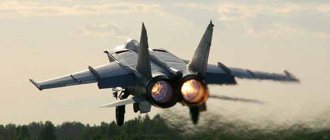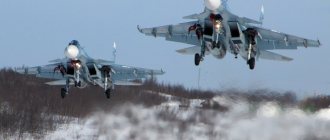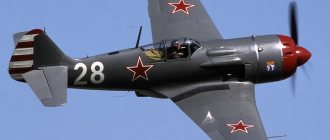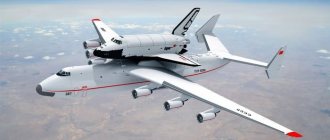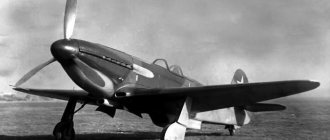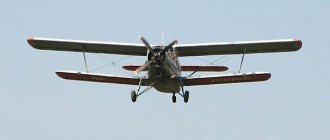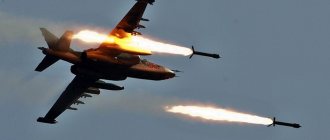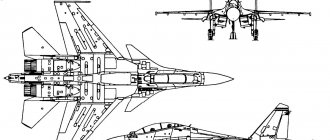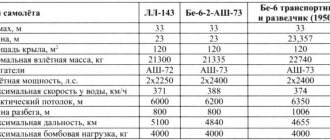An-124-100 cargo plane on takeoff Huge cargo planes invariably attract people's attention, even if these machines are just standing at the airfield. It seems simply incredible that such a large-scale structure can rise into the air. Of course, flying “trucks” were not created to capture anyone’s imagination. They are used in cases where it is necessary to deliver huge turbines of power plants, metro trains, and any other heavy objects with significant dimensions to their destination in a short time. The original purpose of such aircraft is to transport soldiers and military equipment. This is precisely why the world's largest serial cargo aircraft, the An 124 Ruslan, was developed. It was created back in the USSR, and after the collapse of this state, the construction of the machine continued at Ukrainian and Russian enterprises.
History of the development of the An-124 "Ruslan" transport aircraft
In the 60s of the last century, the Soviet aircraft designer Antonov already had several successful aircraft that were used to transport passengers and deliver cargo. The most famous of them was “Antey” - the An-22 military transport.
"Antey" - heavy turboprop An-22
It was capable of lifting up to 60 tons of payload into the air - a record figure for those years. But it was impossible to rest on our laurels, because the United States had already designed the C-5 Galaxy - a much larger and more powerful military transport aircraft in terms of its performance characteristics than the Antey.
American aircraft C-5 Galaxy – predecessor and competitor of the An-124
To catch up with overseas competitors, it was necessary to double the carrying capacity. The task was difficult, however, already in mid-1967, the designers of the Kyiv Mechanical Plant (now ANTK named after O.K. Antonov) immediately developed two projects for new military transport aircraft - the An 124 and the An-126.
For unknown reasons, the study of the prepared technical documentation and drawings took a long time. Only in February 1972, at the level of the Council of Ministers of the USSR, a decision was made to select the An-124 four-engine “truck” project as the main option for further development and construction. By that time, four years had already passed since the first flight of the American transport Galaxy.
It should be noted that the An-126 could become an even more “load-lifting” machine. It was supposed to be equipped with six engines, which made it possible to lift up to 150 tons of cargo into the air versus 120 tons for the An-124. Designing such an aircraft was then considered a risky and premature undertaking. It is possible that such fears were justified, because the creation of “Ruslan” required exceptional efforts. All work was carried out within the framework of a special comprehensive target program, during the implementation of which it was necessary to simultaneously develop metallurgy, electronics and engine building, create new polymer materials with special properties and improve technology.
An-124 in the factory workshop. Assembly was initially carried out in Kyiv, but a significant part of the airframe was made in Tashkent, the landing gear in Kuibyshev (now Samara), and hydraulics in Moscow
The An-124 cannot be called “Ukrainian”, as is sometimes done these days. Literally the entire Soviet Union worked on its creation. This is what allowed the winged aircraft to acquire those characteristics that today still remain a record for serial transport aircraft.
The first copy of the An-124 was taken out of the assembly shop on October 24, 1982. O.K. personally took part in the solemn procedure. Antonov. All this happened, as well as subsequent test runs of the car, in the dark. The plane was carefully hidden from prying eyes. Exactly two months later, a huge winged machine, already named “Ruslan”, took off for the first time.
In 1985, the aircraft was first demonstrated at the Le Bourget air show. It is noteworthy that at first Western experts did not believe that An “Ruslan” had the declared characteristics. To prove to everyone the superiority of the Soviet new product over all other cargo aircraft, it was necessary to conduct demonstration flights, during which more than 20 world records were immediately set. After this, it became clear that the American S-5 is no longer the best in its class.
The last years of the USSR were not the best time for aircraft manufacturers. Perhaps because of this, flight tests of the An-124 were delayed. Only in 1991 this aircraft was officially adopted by the Soviet military transport aviation. True, the actual exploitation of “Ruslan” had already been carried out by this time, and not only in the army. Many commercial firms showed interest in the aircraft.
An-124 at the airfield
The collapse of the USSR disrupted all plans for further production of the An-124. A small number of Ruslans were still built, but after 2004 not a single new vehicle was delivered to customers. Russia and Ukraine conducted long and complex negotiations on this issue, the timing of the resumption of aircraft production was constantly shifted, and then “Euromaidan” happened in Kyiv.
Most likely, new “Ruslans” will no longer appear. A series of contradictory statements from various officials representing both the Russian and Ukrainian governments is not encouraging. Meanwhile, the design of the An-124 is gradually becoming obsolete, and it may soon lose its leading position.
Records and interesting facts
Over the years of operation, Ruslan entered its name into the Book of World Aviation Records more than 30 times:
- The record for lifting cargo into the air was set by an An-124 aircraft on July 26, 1985. "Ruslan" lifted a commercial cargo weighing 171.219 tons to a height of 10.75 km.
- achievements in the range of non-stop flights culminated in a unique record - without refueling, the aircraft flew 20,151 km in 25 hours 30 minutes.
- records for transporting the largest consignment of goods in one flight, transporting the heaviest air cargo and many others.
Dozens of commercial orders completed by Ruslans did not set records, but they amaze the imagination with the variety and weight and size characteristics of the cargo transported.
In the belly of the giant, mining dump trucks and hydraulic turbines, giant Egyptian antiquities and military fighters made flights.
“Ruslans” had to transport such exclusive cargo as gold and currency, concert equipment of the legendary rock band Pink Floyd and anti-aircraft missile systems.
Design Features
According to its aerodynamic design, the An 124 aircraft is a wide-body high-wing aircraft with a single fin. The supercritical wing profile is noteworthy. In the 70s, when the aircraft was being developed, this was an innovation, and quite risky. The final decision to choose just such a profile was made by O.K. Antonov personally, contrary to the opinion of most aerodynamics specialists. As a result, the wings were made “thick”, which greatly simplified their production and made it possible to increase the capacity of the fuel tanks. At the same time, the drag did not change, and the carrying capacity of the Ruslan was increased.
The cargo compartment of the An-124 aircraft. A service staircase can be seen in the background
In the manufacture of the aircraft, aluminum wing and fuselage parts of considerable length were used. Previously, such elements were made prefabricated, which increased their weight and reduced strength. To cast such products, it was necessary to build a new production line, which ensured ideal uniform cooling of aluminum after casting. This process was controlled by the best Soviet computers at that time. There were no such technologies abroad at that time.
The internal layout of the giant aircraft is “two-story”. The lower tier is used to place cargo. On the top there are cabins for two crews (one of them is replaceable) and a room for accompanying persons. The An-124, like the C-5 Galaxy, is equipped with two cargo hatches located in the nose and tail of the aircraft. In addition, there are auxiliary equipment on board - winches, overhead cranes and other devices.
Power point
The Ruslan cargo aircraft is equipped with four D-18T engines. Its immediate prototype was initially supposed to be the American TF-39, created by General Electric engineers, but it soon became clear that this engine did not have the necessary resource. As a result, the D-36, an engine developed for the Yak-42 aircraft, was adopted as the basis.
The main engine of the An-124, D-18T. Created in Zaporozhye at the Motor Sich enterprise (modern name)
The takeoff thrust was increased to 23,430 kgf. For comparison, it can be noted that the C-5 Galaxy engines produced only 18,200 kgf. The design of the D-18T is modular, which allows it to be operated without factory repairs. At the same time, a relatively low noise level and moderate fuel consumption are ensured. It was the engine that made it possible for the Ruslan to be widely used in civil aviation. The creators of the military Galaxy failed to achieve this: the “commercial” L-500 turned out to be an unsuccessful machine.
The An-124 is equipped with two auxiliary power units, which are located in the chassis nacelles and are usually used to supply electricity when starting the main engines.
Fuel system
Each of the aircraft's four main engines is fed with fuel from three "individual" tanks. Fuel is supplied alternately as it is consumed. There is also a separate “common” tank connected to all motors. All thirteen fuel tanks are located in the thick wing of the Ruslan.
Refueling can be carried out either through the upper necks of the tanks, or through four nodes located in the front of the main landing gear fairings. The quality of the fuel is controlled by a special automatic system. When “sludge” forms in the tanks, its simultaneous centralized drainage can be performed. Fuel consumption is carried out in such a way that the alignment of the aircraft is not disturbed - this is monitored by on-board electronics.
A technician performs refueling of an An-124 through the neck in the landing gear fairing
Hydraulic complex
Each of the four Ruslan motors is connected to two powerful plunger pumps. Eight of these devices are the main sources of pressure for the entire complex of onboard hydraulics. In addition to the main pumps, the aircraft is equipped with turbopump units, torque converters and electrically driven NS-55A5 stations.
Flight control system
The An-124 is distinguished by a layout with a small margin of static stability, which is due to the use of a supercritical wing profile. Therefore, a fly-by-wire control system (EDCS) was developed for the aircraft, which was previously used only on fighter aircraft. It was necessary to take into account the enormous size of the machine, which caused a noticeable increase in natural thermal and load deformations during the flight. Using conventional controls would have made the An-124 too heavy, which was unacceptable. EDSU greatly simplified the work of the crew and eliminated the occurrence of flutter—stalls and spins.
In order to increase the level of flight safety, the aircraft is equipped with an on-board automated control system that monitors the operating parameters of all components and mechanisms of the An-124 - from engines to air conditioners. In addition, “supervision” is carried out over the actions of pilots. The system does not allow them to violate existing instructions and regulations.
An-124 cockpit. Main controls – traditional steering wheels
Chassis
Despite its enormous size and carrying capacity, the An-124 can be successfully used on unpaved airfields. This is ensured thanks to two massive main chassis supports. Each of them has 10 wheels on five shock-absorbing struts. The first and fifth axles can be rotated, making it easier to navigate on taxiways. The wheels are equipped with brakes, and during their use, the racks are blown with a directed air flow, which ensures cooling of the discs.
The landing gear is equipped with mechanisms that allow you to “bend” the supports, lowering the fuselage or tilting its nose down. When the aircraft "knees down", unloading it is much easier, especially when transporting large monocargoes.
Communication equipment
Negotiations between the An-124 crew and ground controllers are ensured through the use of a short-wave on-board radio station and a HF receiver. For internal communication, the P-514-2-1 switch is used. Negotiations are recorded with a special tape recorder. All this equipment, together with the control module, is part of the TIP-1B2 complex.
Additionally, “Ruslan” is equipped with a “civilian” transceiver station “Orlan-85ST” and a COSPAS ARB-PK radio beacon. In case of crashes and forced landings in remote areas, the R-855A1 emergency station can be used.
Loading the An-124 through the front ramp. The landing gear is bent, the fuselage is tilted nose to the ground
Flight and navigation sighting system
An important part of the An-124 on-board equipment is the Kupol-124 PNPK. Complexes similar in purpose were installed on other military transport aircraft, in particular on the An-22 and Il-76, however, a special modification was created for the Ruslan.
The complex included:
- Two radar stations (for viewing the earth's surface and the front hemisphere of space);
- Automatic control system;
- On-board computers A-821 (one of them is a backup);
- Navigation system A-826. The operating principle is inertial;
- Equipment that warns of approaching the ground at high speed;
- Indication, control and communication equipment;
- A-825 - flight equipment;
- Airborne signaling systems.
When servicing an aircraft on the ground, objective monitoring equipment installed on board is used. Quadruple redundancy of the electronic equipment that controls roll, heading and pitch during the flight is provided.
Radar and radio equipment
In addition to the already mentioned radars that are part of the flight navigation system, the aircraft is equipped with an A-318 radio compass, an A-034 radio altimeter and a separate A-829 celestial navigation system.
Seats for operators of the An-124 on-board equipment are located behind the pilot's seats
So-called transponders are installed on board, thanks to which the An-124 is displayed on the screens of civilian and military dispatch services. These devices are designated as ATC SO-72M and SRO-2P (product 6202). In addition, radio equipment is used to ensure the takeoff and landing of the vehicle at airfields with distant and near drive stations.
The lateral displacement of the aircraft and its speed are controlled by a Doppler meter DISS Ш013В.
Disaster in Irkutsk
Over the entire period of operation of the An-124 aircraft, 4 aircraft were lost as a result of flight accidents.
One of the most difficult was the fall of a military aircraft in the sky over Irkutsk. Tail number RA-82005 first flew in October 1985. The total flight time of the aircraft at the end of 1997 was 1034 hours, or 576 take-off-landing cycles.
On December 6, 1997, one of the worst flight accidents in the history of military transport aviation occurred. Aircraft RA-82005 was flying from Moscow to the Vietnamese military airfield of Cam Ranh with landings in Irkutsk and Vladivostok. On board were 40 tons of cargo - two SU-27UBT fighters assembled at the Irkutsk Aviation Plant, 15 passengers and 8 crew members.
At 14:42 the plane took off from the Irkutsk airfield.
The further chronology of events was restored with scrupulous accuracy by specialists from the commission to investigate the causes of the disaster:
- 3 seconds after takeoff, height 5 m - surge and shutdown of engine No. 3.
- 9 seconds after takeoff, altitude 22 m - normal stop of engine No. 2.
- 11 seconds after takeoff, altitude 66 m – surge of engine No. 1.
The increase in angular velocity and angle of attack did not exceed the permissible values, but due to a sharp loss of thrust after stopping three of the four engines, the An-124 began to roll to the left and sharply decline with a simultaneous loss of linear speed.
The crew was unable to stabilize and keep the plane in flight with one working engine.
A giant plane fell 1.6 km from the Irkutsk-2 airfield on the city's Aviastroitel microdistrict. The main blow fell on house No. 45 on the street. Civil. The keel of the plane hit the wall of house No. 120 on Mira Street, and other large debris hit the building of an orphanage.
The total number of deaths in the plane crash is 72 people:
- 49 of them were victims of a catastrophe on earth, residents of Irkutsk, 15 of them were children.;
- 15 — Ruslan passengers;
- 8 - crew members.
70 families lost their homes. Hundreds of military and civilian specialists and equipment from the rescue center of the Russian Ministry of Emergency Situations took part in eliminating the consequences of the disaster.
An investigation conducted by a state commission named the official cause of the plane crash as the failure of 3 of the 4 engines in the power plant.
The situation was complicated by the fact that the on-board recorders of crew conversations and technical parameters of the aircraft were very badly damaged in the fire. Privately, after the completion of the official investigation, interviews appeared in which military and civilian experts and specialists expressed different points of view regarding the reasons for the failure of the Ruslan engines after takeoff.
The facts given below are unofficial and cannot be used as conclusions about the degree of culpability of the manufacturer, crew or technical personnel:
- reloading the aircraft before departure from the Irkutsk airfield.
- disruption of the operation of one of the on-board systems due to the use of prohibited electronic devices by one of the passengers.
- Exceeding the amount of 9 water in aviation kerosene and, as a result, the appearance of ice and failure of fuel filters of turbojet engines.
In 1999, at the site of the fall of “Ruslan” in Irkutsk, the Church of the Nativity of Christ was consecrated, erected in memory of the victims of the terrible disaster.
Performance characteristics
The main operational parameters that the An 124 “Ruslan” has:
| Maximum take-off weight | 405 tons |
| Empty weight | 173 tons |
| Fuel supply in internal tanks | 213,714 tons |
| Aircraft length | 69.1 m |
| Height | 20.78 m |
| Wingspan | 73.3 m |
| Speed | 865 km/h – maximum, 800 km/h – cruising |
| Range of flight | 7,500 km with a load of 80 tons, 4,800 - with a load of 120 tons |
| Service ceiling | 11,600 m |
The maximum carrying capacity “according to the passport” is 120 tons, but in practice the aircraft sometimes carried 132 tons. In addition, it must be taken into account that if for the C-5 Galaxy the maximum permitted weight of a “monocargo” is 50 tons, then the Ruslan can transport the same amount without obtaining special permission. When completing this document, the permissible weight of a “monocargo” reaches 120 tons.
Another “oversized” cargo delivered to its destination
Advantages and disadvantages
The main advantage of the Ruslan was and remains its unique carrying capacity combined with the ability to transport large items.
There are other advantages:
- Ease of piloting. For such a huge machine, this is a very valuable characteristic. Pilots are especially concerned about landing on massive landing gear;
- Well-thought-out internal layout, the presence of convenient hatches for loading and unloading;
- Availability of a chassis “bending” system;
- High level of reliability of all on-board systems.
In many cases, only Ruslan is capable of providing high-speed delivery of goods. It is no coincidence that this aircraft was used to carry out missions for the United Nations.
The An-124 has two disadvantages. The first of them is the high cost of transportation, compared to transport versions of the Boeing 747. Because of this, Ruslans are used only in cases where loading using a ramp is required: Boeings are simply incapable of this. The second drawback is the clearly outdated cockpit equipment, which does not meet the requirements of today.
An-124 modifications
An-124-100M-150 - a modification with a payload capacity increased to 150 tons.
The Ruslan aircraft has relatively few options:
- An-124. The original modification intended for Soviet military transport aviation;
- An-124-100. "Demobilized" version of the aircraft. Used for commercial purposes. Changes were made to the onboard equipment, in particular, the flight navigation system was modernized, instruments with the American measurement system were used (speed - in knots, altitude - in feet);
- An-124-100M. The crew of this version of Ruslan does not include 6 people, but only 4. The reduction was achieved thanks to improvements in on-board electronics;
- An-124-100M-150. Modification of the aircraft with increased payload capacity to 150 tons. There is also a variant 124-100-150 with the same on-board equipment.
The modernization of Ruslan to the level of 124-100M was carried out only in Russian military transport aviation. There are 22 such machines in total. Prospects for the further development of the aircraft remain vague, including due to tense relations with Ukraine.
PD-35 and all, all, all
In 2016, however, the situation changed. As part of the development of the joint Russian-Chinese wide-body aircraft CR-929, Russia began designing the ultra-high-thrust PD-35 engine, while experts noted from the very beginning that this project is considered promising from the point of view of equipping new transport aircraft - it does not matter whether it is PD -35, or its variant with other thrust figures. In the development of the PD-35, it is planned to use the groundwork obtained from the creation of the PD-14 medium-thrust engine, which is currently undergoing flight tests, as well as technologies obtained from the creation of a new generation of engines for combat aircraft.
Ruslan_3
Medium thrust engine PD-14
Photo: commons.wikimedia.org/Vitaly V. Kuzmin
In 2022, information appeared about the allocation of 64.3 billion rubles for R&D for the PD-35 project until 2023, which indicates a fairly serious approach to the project. The total volume of investments should be 180 billion, with the bulk of them falling in the mid and second half of the 2020s, when the new engine will be put into production.
The first modernized Il-76MD-M was handed over to the Russian Ministry of Defense
From the point of view of the prospects for resuming the production of super-heavy military transport aircraft in Russia, the engine is a key object, and the success of the work on it will determine the success of the project as a whole.
